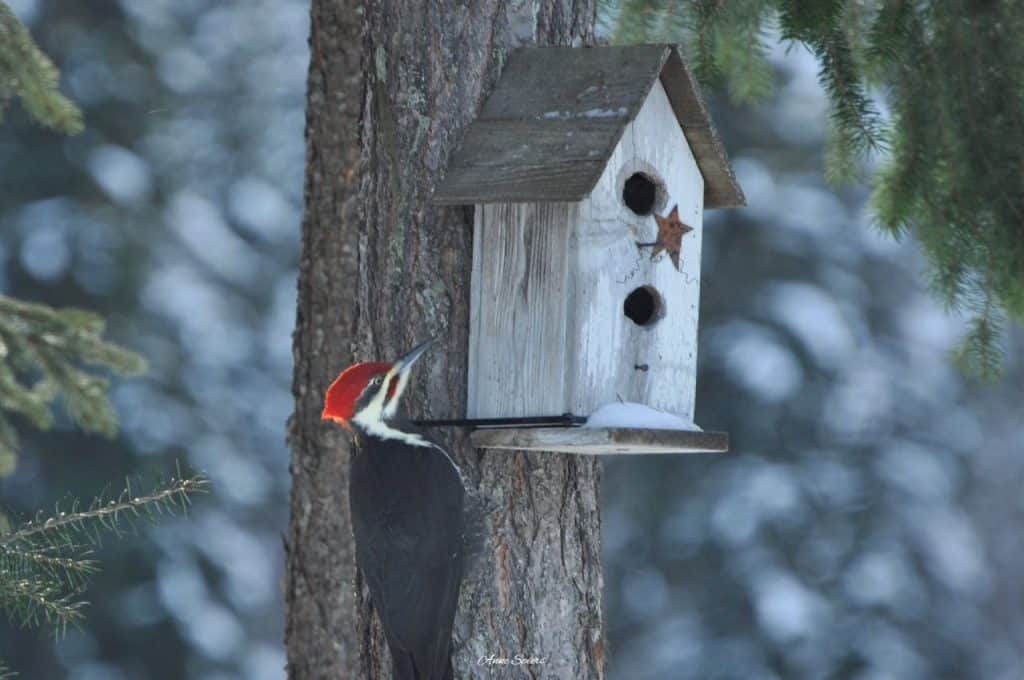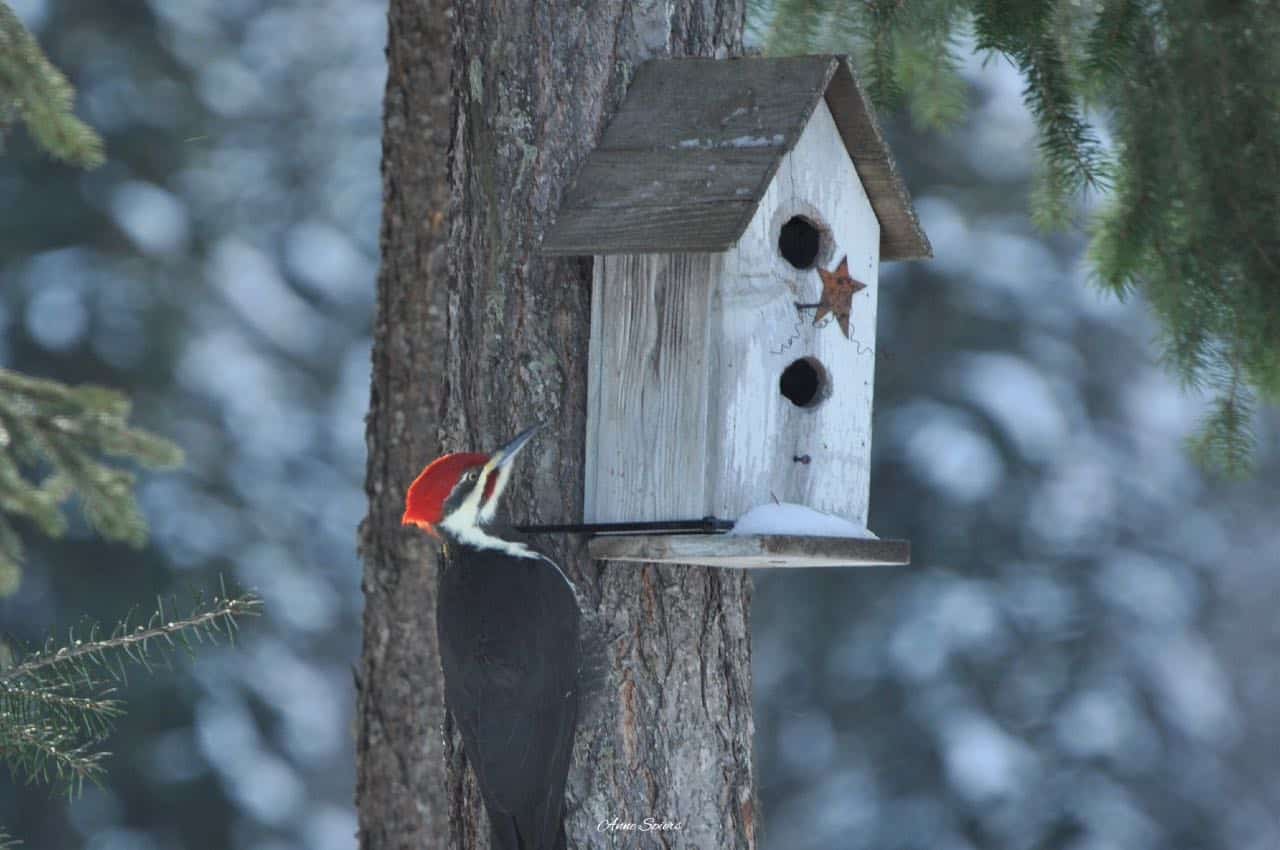Inside: Wondering about pileated woodpecker nesting boxes? Like, will they even use a nesting box? Keep reading. In this article, I describe the type of nest pileated woodpeckers have and I spill the beans on whether pileated woodpeckers would even use a nesting box.
Once in a while, you’re introduced to a bird species that makes you go “Wow, I need to know more about this one!”. Enter the pileated woodpecker.
A member of the woodpecker family, the pileated is the largest in North America and most recognizable. Who wouldn’t want to attract a pair of pileated woodpeckers to their yard? Offering a nesting box is the perfect way to attract birds to your yard. But would they use it? Would a pileated woodpecker actually use a nesting box?

Will pileated woodpeckers nest in a nesting box?
Yes, but it’s not the norm. In fact, it’s rare. Pileated woodpeckers have been known to use a manmade nesting box but they prefer to build their own natural nest.
To best understand why pileated woodpeckers prefer to build their own nest we first need to understand the type of nest they have.
pileated woodpeckers Nest Type
Pileated woodpeckers nest inside tree cavities. More specifically, tree cavities they excavated themselves to detailed specifications.
In spring, when the male and female pileated woodpecker are preparing for the breeding season, they’ll find a tall dead or dying tree and spend up to 6 weeks excavating the perfect size hole to lay eggs and raise their family.
They’ll select a variety of tree species, depending on where the woodpecker pair lives within their range including:
- Ponderosa pine
- Western Hemlock
- Douglas-fir
- Various broadleaf deciduous trees
In the west, they’ll even use large dead conifers. Conifers are plants that have cones (e.g. pinecones).
In the east, they may opt for hardwood trees with heart rot. (Heart rot is a fungal disease that causes the decay of wood at the center of the trunk and branches.)
Check out this close up of a pileated woodpecker pair and their natural nest cavity:
Pileated woodpeckers never use the same cavity for subsequent nests. They may excavate a new cavity in the same tree in later years but never use the same cavity.
They may roost inside a previously used nest but as mentioned, will never use it again for nesting purposes.
Sometimes they’ll begin excavating a nest and before completing it, start another nest. Years later the pair may return to the initial nest and complete and use it for that breeding season.
Other times they may complete several nests in spring, only use one that season and return years later to use one of the other nests.
The pair creates an entrance wide enough to permit several babies to beg from the opening at once. The average entrance hole is elliptically shaped with an area of about 9.5 sq inches.
Check out these sweet pileated woodpecker babies peepin’ out of the cavity specially constructed by their mom and dad:
Pileated Woodpecker Nest’s Average Tree & Cavity Dimensions
Stephen A. Shunk has researched woodpeckers extensively. His research is compiled into an amazing book called Peterson Woodpeckers of North America.
Based on Stephen’s research, we know the average dimensions of the pileated woodpecker’s natural nesting cavity and the trees they choose to build them in.
Average Tree & Cavity Dimensions of Pileated Woodpecker Nest
| Tree: Height | 60 – 95 feet |
| Tree: Diameter | 1 – 3 feet |
| Cavity: Average height from ground to bottom of entrance | 33-57.5 feet |
| Cavity: Min, max height | 17-58 feet |
| Cavity: Average elliptical area of entrance | 9.5 sq. inches |
| Cavity: Average vertical depth from upper to lower apex | 14.5 – 17 inches |
| Cavity: Average interior diameter at widest point | 5 inches |
| Cavity: Compass direction of entrance | 45 -180 degrees (Northeast – South) |
By the way, if you’re as fascinated by woodpeckers as I am, I highly recommend picking up a copy of Stephen’s book. You can get it here on Amazon: Peterson Woodpeckers of North America.

When will pileated woodpeckers use a nesting box or birdhouse?
As mentioned earlier, pileated woodpeckers will use a nesting box or birdhouse only on rare occasions. Here are two examples of these rare occasions:
- If the woodpecker pair is living in a forested area that’s absent of tall dead or dying trees, they may be forced to settle for a man-made nesting box.
- According to Nestwatch, pileated woodpeckers may use a nesting box when you already see the birds nesting in utility poles. This makes a lot of sense. If a natural nesting tree was available the pair would choose that over a utility pole, so why not a man-made nesting box?
Outside of the breeding season, pileated woodpeckers and many other woodpeckers and songbirds may use the nesting box for roosting. This is especially true in winter when a shelter is crucial for survival.
If you’re going to go to the effort to get and install a nesting box you want to make sure they’ll use it, right?
Of course, the nesting box needs to be large enough to accommodate a pileated woodpecker and its babies. It also needs to be located within their preferred habitat. More on that later.
Tips for Offering a Nesting Box to Pileated Woodpeckers
We’ve already established pileated woodpeckers will only use nesting boxes under certain circumstances but really prefer to excavate their own.
If you live in a forested area within their range and want to offer them a man-made nesting box, here are three tips to help you succeed:
- Buy or build a nesting box that suits the pileated woodpecker.
- Enable the woodpeckers to excavate the nesting box.
- Place the nesting box in the location and in the direction they would have their natural nest.
Tip #1: Buy or Build a Nesting Box That Suits the Pileated Woodpecker
This may sound obvious, but some people will put out any old nesting box and expect the pileated woodpecker to use it. Nope. This bird has unique attributes that must be accounted for. Specifically – size, tail & perching position.
Either buy or make a nesting box that suits this giant bird’s size, tail, and perching stance.
Size: Pileated woodpeckers are the largest woodpeckers in North America sizing at about 16-19” in length. So, the nesting box needs to be large enough to accommodate the bird as it rests vertically on the side of it while feeding its babies.
Tail: This woodpecker has a long perching tail fully equipped with stiff tail feathers designed to prop him against a tree. If the nesting box is appropriately sized, as mentioned above, the bird should be able to comfortably rest its tail on the front panel.
Perching Stance: In true woodpecker fashion, pileated woodpeckers leverage their unique feet & toes to perch on the vertical of trees. While feeding, it’ll position its long toes & claw-like tips onto the side of trees and rest there while it feeds.
The texture of the tree and bark enables the bird to grab on. For this reason, 70birds.com recommends using rough-cut wood stock on the outside and inside when building a pileated woodpecker birdhouse or nesting box.
Tip #2: Enable Woodpeckers to Excavate the Nesting Box
This will sound weird but to encourage pileated woodpeckers to use a man-made nesting box you should stuff it with wood shavings. I mean stuff it – really tight!
The idea is to mimic the density of a tree that pileated woodpeckers would normally peck into to create their natural cavity.
Tip #3: Place the Nesting Box Where the Pileated Woodpecker’s Natural Nest Would Be
Unless you’re willing to erect a utility pole, your best bet is to find a tree to mount the man-made nesting box on.
Ideally, the tree will mimic the type and size the pileated woodpecker would actually choose when constructing their own natural cavity nest.
Find an appropriate tree and securely mount the nesting box facing it northeast – south.
Based on Stephen A. Shunk’s research (see above) the average tree pileated woodpeckers build their natural nests in is 60-95 feet high, 1-3 feet in diameter. And, the cavity faces Northeast – South.
If you’re paying attention you know the average nest cavity is built 33-95 feet high. In the air!
Maybe you could call your local fire department and ask if they can bring their ladder truck over. Just joking. I have no idea how you would mount the nesting box at that height. Frankly, I don’t recommend it due to safety concerns.
I suggest mounting the nesting box at a (lower) height that you can safely and comfortably mount it. Who knows, you just may attract a pileated woodpecker pair.
Wrapping Things Up
Pileated woodpeckers are one of Mother Nature’s amazing creations. Together, the male and female pair excavates the perfect nest high in the tree of a forest to raise their family. A year later they do it again, and again.
Who wouldn’t want to host this enormous woodpecker in or near their yard? We all would but the reality is they prefer to build their own nest and are unlikely to use a man-made nesting box to nest in.
So, when spring rolls around, keep your eyes peeled for loud drumming and pecking high in the trees – it just may be a pileated woodpecker excavating their nest.




